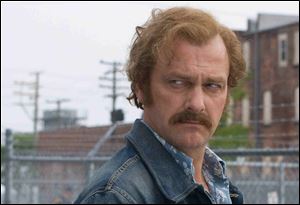
It's no 'Godfather,' but 'Kill the Irishman' appeals to genre's fans
6/23/2011
Ray Stevenson in 'Kill the Irishman.'
"Cleveland 1975," reads the opening caption in Kill the Irishman, as shots of an industrial city and soul music from the '70s playing on a car radio further set the scene. Danny Greene is driving through Cleveland, enjoying the music and his neighborhood, when the radio starts to sputter and spark. He jumps out of the car just before a bomb explodes and his car is engulfed in fire. Shaken but uninjured, Danny yells, to no one in particular, "Is that all you got? It's gonna take more than a few firecrackers to kill Danny Greene."
Based on the true story of an Irish-American gangster who took on the Italian mob and survived a series of assassination attempts, Kill the Irishman is out this week on DVD following a limited theatrical release earlier this year (Anchor Bay Films, $29.98/$34.99 Blu-ray, rated R). I liked Kill the Irishman a lot, but I don't want to overstate the case for it. It was made by a relatively unknown director, Jonathan Hensleigh (The Punisher), and stars an actor, Ray Stevenson, who, if he is recognized at all in this country, it would probably be from playing the Roman soldier Titus Pullo in HBO's Rome. It's a small-scale film, but it packs a solid punch.
Following the opening scene, the movie moves back in time to show Greene's tough early life as an Irish kid battling Italian kids in Cleveland's working-class ethnic neighborhoods, his job as a longshoreman, his rise to the presidency of his union local, and eventually his emergence as a fearless, independent mobster and self-proclaimed "Celtic Warrior."
By the 1970s, Greene has gathered the money and muscle to wage a turf battle with the Cleveland Mafia and its bosses in New York.
Though Stevenson might not be familiar to viewers, he's joined by a bunch of well-known and talented actors, including Vincent D'Onofrio as mobster John Nardi, who breaks ranks with his fellow Italian Americans to work with Greene, and the always reliable Christopher Walken, who plays Jewish restaurant owner and loan shark Shonder Birns, a friend of the Mob. Though underused, Val Kilmer easily handles the role of a Cleveland police detective investigating organized crime. (As an onlooker, Kilmer also serves as the film's narrator, a device borrowed from Martin Scorsese's GoodFellas and Casino).
In addition, lending the film a curious authenticity is the presence of many character actors who are instantly recognizable from their roles as gangsters in movies and television: Steve Schirripa (The Sopranos), Tony Lo Bianco (The French Connection), Paul Sorvino (GoodFellas, The Firm), Tony Darrow (GoodFellas, The Sopranos), Robert Davi (Wiseguy), and Vinnie Jones (Lock, Stock and Two Smoking Barrels). There are no women's roles here as good as, say, Diane Keaton's and Talia Shire's in The Godfather films or Edie Falco's and Lorraine Bracco's The Sopranos, but Linda Cardellini (as Greene's wife) and Fionnula Flanagan (as Greene's crusty neighbor) are skillful complements to Stevenson.
Despite using Detroit, another city on the Great Lakes, as a stand-in for Cleveland, Kill the Irishman is carefully precise in its depiction of industrial urban America. Early scenes from the 1960s of longshoreman performing dangerous jobs on the docks of Lake Erie and images of working-class neighborhoods in the '70s realistically capture the grime and grim lives faced by blue-collar workers and their families.
The use of contemporary music on the film's soundtrack is also well thought out. For instance, the opening song, "(I'm Gonna) Keep On Loving You" by the Sam & Dave soundalike group Kool Blues, actually was released in the early '70s by the obscure Capsoul Records label out of Columbus. These tunes blend in well with Patrick Cassidy's original score, which makes good use of traditional Irish music.
Judging by Danny Greene: The Rise and Fall of the Irishman, a one-hour documentary that's included on the DVD, Greene was more evil than he is portrayed in Kill the Irishman. In the movie, Greene's generosity toward those in his neighborhood (he was nicknamed "The Robin Hood of Collinwood"), his buoyant spirit and sense of humor, and his fearlessness in facing numerous attempts on his life just about trump his viciousness, corruption, and propensity for violence. This, at least, is the slant of Hensleigh and Jeremy Walters' screenplay, which was based on Rick Porrello's true-crime book To Kill the Irishman, but it's not the fault of Stevenson's performance.
Stevenson, who was born in Northern Ireland but reared in the north of England, brings both the strength and power of a thug and the sensitivity and intelligence of a reasonable man to his role as the charismatic Greene. It's certainly satisfying when the youngish Greene uses his smarts and his muscle to oust the corrupt president of the longshoreman's union, played by Bob Gunton (the memorably evil warden in The Shawshank Redemption), and, as in most good gangster movies, we appreciate the courage and audacity of a man willing to go up against more powerful foes. Then again, Hensleigh never shows Greene extorting and abusing innocent people in his pursuit of wealth and power.
Kill the Irishman is not in the same league as The Godfather films, GoodFellas, Casino, The Sopranos, The Wire, The Usual Suspects, or the best gangster movies of the past. But it will give fans of the genre a solid 106 minutes of action, suspense, and fine acting.